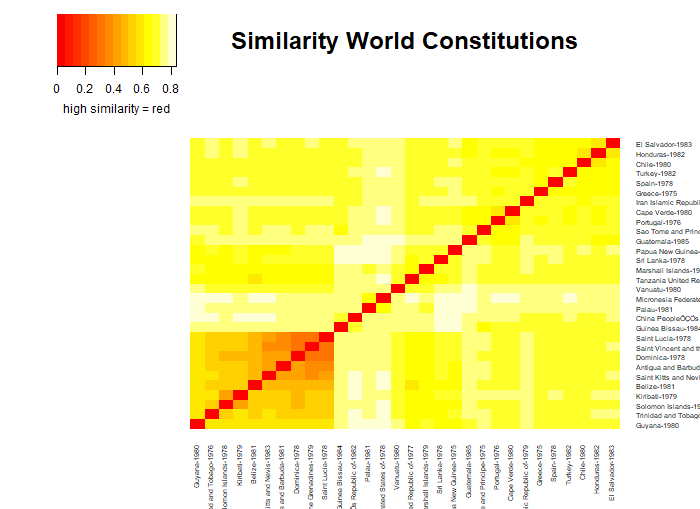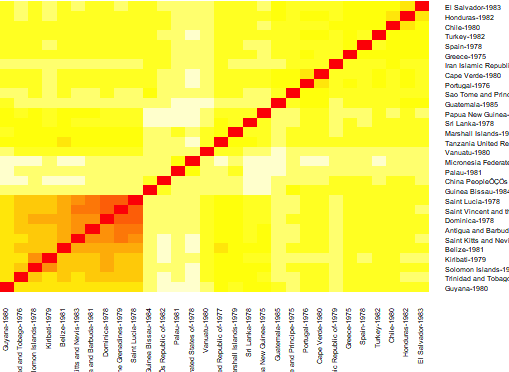A constitution’s primary role is to describe the rules a government must obey when governing a country. The documents set clear “rules of the game” and protect a population from their government’s abuses of power. Yet, in every country, the optimal rules and protections will be different. As a result, protections that may allow one society to flourish may hold another back. It is important that a constitution is crafted to protect the individual needs of the society it is protecting.
For this reason, the process of drafting a constitution is often painstaking. To do a good job, governments must craft protections in coordination with both legal experts and their civil society. This often includes an in-depth consultation process accross a country. Yet, this is not always the case.
The history of colonization is still felt to this day in so many ways. This legacy includes the constitutions that regulate the countries in the Caribbean. These constitutions offer many important protections that underpin a democratic society. Yet, the evidence suggests that their civil societies had little input.
Between 1975 and 1985, a host of former British colonies in the Caribbean repatriated their constitutions. This allowed the countries to reclaim control of their governance, or so it seemed. Instead, however, these countries adopted constitutions that were almost identical. While this clarified the rules of the game and protected fundamental rights, these societies may not have adopted constitutions adapted to their unique needs.
This blog post will use a similarity analysis introduced in Lesson 6 to identify a cluster of constitutions with an unusual level of similarity. Then, it will identify the two most similar constitutions, Saint Vincent and the Grenadines in addition to Saint Lucia, and use them as a case study to illustrate what these similarities look like. Finally, we will discuss the benefits and pitfalls of such an arrangement.
What is a Similarity Analysis?
Similarity measures help investigate legal content. Often, contracts, statutes, and treaties are built from templates. Additionally, case law often incorporates wording that is nearly identical to other precedents. This means that these texts contain provisions with already-established meanings. In turn, this helps promote legal certainty, because similar language may have already been interpreted by other courts. For example, researchers associated with this website performed an exhaustive analysis of bilateral investment treaties at www.mappinginvestmenttreaties.com.
Similarity measures exploit these patterns. They quantify the similarity between two documents and help identify unique passages. This reveals sub-groupings within a large corpus. Here, we look for sub-groupings of constitutions.
Using Text-as-Data Analysis to Determine Similarity
First, we define the constitutions that we want to analyze. In this post, we will be looking at constitutions adopted between 1975 and 1985. So we subset our data to match this timeframe
#Reduce the corpus dataframe to the constitutions adopted between 1975 and 1985
from1975to1985 <- constitution_texts[which(constitution_texts$year_of_adoption > 1975 & constitution_texts$year_of_adoption < 1985), ]
Next, we will use a distance 5-gram matrix to determine the similarity between the constitutions. This method converts each constitution into 5-character segments. Subsequently, we compare to what extent these 5-character segments overlap in constitutions. Formally this is known as their Jaccard distance and will result in a distance matrix. Differently put, the distance matrix quantifies the textual similarity of the constitutions under investigation. This method does not analyze the underlying meaning of the constitutions but instead makes statistical comparisons of the use of the words and letters themselves.
# activate package "stringdist" (install the package first if you have not done so)
library(stringdist)
# Create a distance matrix
distance_matrix_5gram <- stringdistmatrix(from1975to1985$text,
from1975to1985$text,
method = "jaccard",
q = 5)
Next, we build on Lesson 6 and visualize this distance matrix as a heat map. This visualization is in the discussion section. Each of the lines of code below determine the settings of the heatmap. This includes the type of statistical comparison, the information that is inputted, the titles, and what the visualization looks like.
#Creating a heat map based off of the above distance matrix
heatmap.2(distance_matrix_5gram,
dendrogram='none', # no dendogram displayed
Rowv=TRUE, # column clustering
Colv=TRUE, # row clustering
symm = TRUE,
trace='none',
density.info='none',
main = "Similarity World Constitutions", #heat map title
labCol = paste(from1975to1985$country,from1975to1985$year_of_adoption,sep="-" ),
labRow = paste(from1975to1985$country,from1975to1985$year_of_adoption,sep="-" ),
cexRow = 0.5,
cexCol = 0.5,
key.title = NA,
key.xlab = "high similarity = red",)
Finally, we identify the constitutions that are most similar. These are the constitutions of Saint Lucia in addition to Saint Vincent and the Grenadines.
Saint_Lucia_Text <- from1975to1985[9,]
Saint_Vincent_and_the_Grenadines_Text <- from1975to1985[16,]
d_mat_Lucia_and_Vincent <- stringdistmatrix(from1975to1985$text[which(from1975to1985$country=="Saint_Lucia")],from1975to1985$text[which(from1975to1985$country=="Saint_Vincent_and_the_Grenadines")], method = "jaccard", q = 5)
Discussion
In this section, we will discuss what similarities these Caribbean nations shared. In doing so, we identify a British influence on their institutional design and the rights that were protected.
Overarching Patterns
The heat map below depicts the textual similarity of the constitutions adopted between 1975 and 1985. Clustered by similarity, it shows that many of the former British Colonies in the Caribbean have similar constitutions. The heatmap is symmetrical, meaning that both axes display the same information and follow the same order. Thus, the diagonal red line represents treaties being compared with themselves. The other red-tinted squares represent an unusual level of similarity. At a high level, we can identify a pattern of similar constitutions in the bottom-left corner.

After looking over the contents of the constitutions, the British influence on their design is evident. Each of these constitutions is organized in the same order. The constitutions protect fundamental freedoms, life, liberty, against inhumane treatment, conscience, expression, assembly, and against discrimination. Further, they offer the protections in that order. These constitutions also use language that is almost identical to protect these rights. As such, many of these countries have the exact same constitutional protections.
Finally, each of the countries in this cluster, except St. Kits and Nevis, have a Westminster style of government with a Governor-General, a legislature, and a senate. This shows that these countries developed institutions that resemble those of the British Empire.
Comparing Saint Lucia with Saint-Vincent and the Grenadines
Next, we will analyze the two most similar constitutions. 71% of their text is identical. This compares to an average similarity of 34% in the time period.
The following table compares a few articles in both constitutions. Not only do both constitutions offer similar protections, but they do so by using almost identical wording, in identical order. It is useful to note the similarity between these two constitutions. Further, these three articles are just the beginning. There are many other identical articles.
| Saint Lucia | Saint Vincent |
| Article 1 Whereas every person in Saint Lucia is entitled to the fundamental rights and freedoms, that is to say, the right, whatever his race, place of origin, political opinions, colour, creed or sex, but subject to respect for the rights and freedoms of others and for the public interest, to each and all of the following, namely- a. life, liberty, security of the person, equality before the law and the protection of the law; b. freedom of conscience, of expression and of assembly and association; and c. protection for his family life, his personal privacy, the privacy of his home and other property and from deprivation of property without compensation, the provisions of this Chapter shall have effect for the purpose of affording protection to those rights and freedoms subject to such limitations of that protection as are contained in those provisions, being limitations designed to ensure that the enjoyment of the said rights and freedoms by any person does not prejudice the rights and freedoms of others or the public interest. | Article 1 Where every person in Saint Vincent is entitled to the fundamental rights and freedoms, that is to say, the right, whatever his race, place of origin, political opinions, color, creed or sex, but subject to respect for the rights and freedoms of others and for the public interest, to each and all of the following, namely a. life, liberty, security of the person and the protection of the law; b. freedom of conscience, of expressions and of assembly and association: and c. protection for the privacy of his home and other property and from deprivation of property without compensation, the provisions of this Chapter shall have effect for the purpose of affording protection to those rights and freedoms subject to such limitations of that protection as are contained in those provisions, being limitations designed to ensure that the enjoyment of the said rights and freedoms by any person does not prejudice the rights and freedoms of other or the public interest. |
| Article 4.1 No person shall be held in slavery or servitude. 2. No person shall be required to perform forced labour | Article 4(1) No person shall be held in slavery or servitude. (2) No person shall be required to perform forced labor. |
| Article 8.1 If any person is charged with a criminal offence, then, unless the charge is withdrawn, the case shall be afforded a fair hearing within a reasonable time by an independent and impartial court established by law. | Article 8(1) If any person is charged with a criminal offence, then, unless the charge is withdrawn, the case shall be afforded a fair hearing within a reasonable time by an independent and impartial court established by law. |
Discussion
The similarities that the constitutions share are a mixed blessing. On the one hand, these two constitutions protect many of democracy’s highest ideals. These protections are vital to having individuals live dignified lives. Further, these protections are embedded in the British rights tradition that protects individuals from state actions, and in a canon of well-developed jurisprudence.
On the other hand, constitutions should reflect the desires of the local population. Each country should be in control of the decisions made within its borders. Yet, here it appears that these countries did not play an active role in drafting their own constitutions. It is unlikely that a constitution drafted with an engaged civil society would be identical to another country’s constitution. As such, the populations in these countries may have to abide by a set of constitutions that do not fully reflect their values.
Of course, what these rights protect may vary according to how their courts interpret the provisions. A constitutional right to life even if expressed in similar words likely remains purposefully broad which means that it can be interpreted in different ways in different countries. While this may give rise to a distinct legal culture, the country may still be left with protections that do not fully match their needs.
In Saint Lucia, Saint Vincent and the Grenadines, and throughout the rest of the British Caribbean, countries have constitutions that protect many of the high ideals of liberal democracy. Yet, oftentimes these high ideals were not crafted by that society. As such, there may be some aspects of their culture that are prized by the local population, but which are left unprotected.
Constitutions R Similarity Analysis